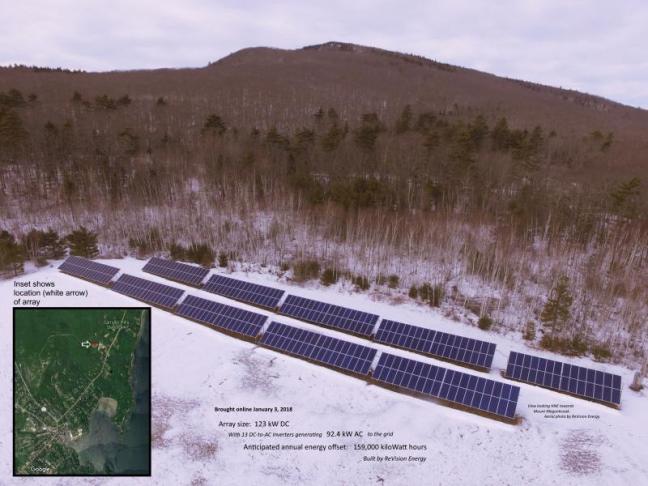CAMDEN — In January 2018, Camden began sending power to the regional electrical grid via its new solar photovoltaic system at Sagamore Farm. The intent of the 351-panel array was, and is, to offset an estimated 159,000 kilowatt hours (kWh) of electrical energy used by the town per year (amounting to approximately 7 percent of Camden’s annual electrical use in 2014, according to the town’s Energy and Sustainability Committee).
That electricity has traditionally been purchased from Central Maine Power. CMP does not generate power, but it does transport electricity via its system to its markets, and many Midcoast municipalities have similar arrangements after investing in solar arrays to offset electrical costs for their taxpayers.
But Camden learned in March that it had been over-charged $15,000 by CMP. The town has nine separate electrical accounts, and it discovered that CMP had been overcharging those accounts after CMP sent the town a check for $15,000 for the overpayment.
“CMP was still billing for electricity when we should have only been charged for delivery,” said Camden’s Finance Director Jodi Hanson.
Town Manager Audra Caler-Bell informed the Camden Select Board at its most recent meeting, March 26, about the billing issue and said the town was looking into the issue.
But CMP has an explanation for what happened. According to CMP Corporate Communications Manager Catharine Hartnett: “Understanding that this information has been tracked through the billing records, and understanding that we have 640,000 customers, I may be a little short on some of the why's, but from what we can determine, CMP set up a new account in March 2018 for Camden to reflect the new net energy billing arrangement. There are nine associated town accounts in Camden — municipalities can have up to 10 that are determined by the towns and can be created for specific buildings or facilities. Upon setting up the new account, the nine associated accounts were not linked to the ‘parent’ account, and therefore the credits from the solar array were not properly credited across the accounts.”
She added: “To properly credit the accounts, CMP voided all bills back to March of 2018 and applied the credits across all nine accounts resulting in the $15,000 credit. I can see that this could be a lesson for towns that juggle multiple electric accounts and implement a new form of energy generation; simply ensure the credits produced by the generation are reflected across all designated accounts.”
‘Going solar’ for many municipalities is a learning curve, not just for the town offices but for taxpayers, as the strands of money get sorted out between power generation, transport and credit.
In Camden, it works like this:
The town signed a Power Purchase Agreement (PPA) financial structure with ReVision Energy that required no up-front investment from the town. Instead, Camden pays ReVision quarterly for the array and its electricity generated at a rate comparable to the rate Central Maine Power charged in 2017 ($0.124 per kWh). Its bill for the first quarter of 2019 (January, February and March) was $8,034.
ReVision supplied and installed the panels at Sagamore Farm.
While ReVision currently owns the solar panels, eventually Camden has the option of assuming ownership of them in six years, and can credit its solar power to CMP. It is an arrangement similar to other Midcoast municipalities which are also supplementing their electrical supply with solar, in contracts with private solar companies.
The energy generated from the solar array is sent to the grid along CMP power lines.
“It feeds other neighbors along Route 1 corridor,” said Jennifer Albee, of ReVision Energy. “Any of that power goes back to the grid, and literally gets distributed to neighbors along Route 1. It runs along the power grid just as other power does.”
ReVision keeps track of power generated at Sagamore Farm through an online monitoring. CMP also has its own meters at the site, “they can read at any point,” said Albee. CMP keeps track of what goes back to the grid and then credits Camden for what power it produces with the array.
The CMP meters at Sagamore Farms are smart meters, meaning software tracks what power is being generated and technicians can record that information remotely at their own computers.
The performance of the solar array can be monitored live online by the public through this link: http://kiosk.datareadings.com/cnFBqQGL/overview?slideshow=true
Reach Editorial Director Lynda Clancy at lyndaclancy@penbaypilot.com; 207-706-6657


























